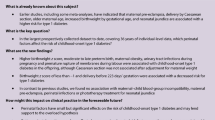Abstract
Objective
To evaluate the risk of adverse perinatal events among newborns exposed to dipyrone during gestation.
Design and Setting
The present study is a secondary analysis of Brazilian study of gestational diabetes (EBDG), a cohort of women attended at healthcare units of the Brazilian national health system (SUS) located in six Brazilian state capitals, between February 1991 and June 1995.
Sample
A total number of 5,564 women aged 20 years and over who were between their 21st and 28th week of pregnancy were followed up.
Methods
A structured questionnaire was used to obtain data on the pregnant women, their pregnancies, and their use of medications. Other data and the outcomes congenital abnormalities, intrauterine death, preterm birth, or low birth weight were obtained from the medical records. To estimate the odds ratios after adjustment for the potential confounding factors, logistic regression modeling was developed.
Main outcome measures
Congenital abnormalities, intrauterine death, preterm birth, and low birth weight.
Results
Dipyrone use was reported by 555 pregnant women (11.5%). Their exposure to this medication did not present any association with the outcomes of congenital abnormalities (OR 1.11; 95% CI, 0.58–2.10), intrauterine death (OR 0.69; 95% CI, 0.33–1.43), preterm birth (OR 0.94; 95% CI, 0.73–1.20), or low birth weight (OR 0.88; 95% CI, 0.64–1.22), in the crude analysis. This absence of associations was maintained after performing logistic regression analysis.
Conclusions
The data suggest that the exposure to dipyrone during pregnancy does not increase the risk of congenital abnormalities and other adverse events as outcomes from pregnancy.
Similar content being viewed by others
References
The international agranulocytosis aplastic anemia study (1986) Risks of agranulocytosis and aplastic anemia. A first report of their relation to drug use with special reference to analgesics. JAMA 256:1749–1757. doi:10.1001/jama.256.13.1749
Andersohn F, Konzen C, Garbe E (2007) Systematic review: agranulocytosis induced by nonchemotherapy drugs. Ann Intern Med 146:657–665
International panel on the evaluation of safety of dipyrone use (on line) (2007). Available on 20 April 2007 at http://www.anvisa.gov.br/divulga/informes/relatoriodipirona2.pdf
Mengue SS, Shenkel EP, Duncan BB, Schmidt MI (2001) Drug use by pregnant women in six Brazilian cities. Rev Saude Publica 35:415–420. doi:10.1590/S0034-89102001000500002
Fonseca MR, Fonseca E, Bergsten-Mendes G (2002) Prevalence of drug use during pregnancy: a pharmacoepidemiology approach. Rev Saude Publica 36:205–212
Sharpe CR, Franco EL (1996) Use of dipyrone during pregnancy and risk of Wilm’s tumor. Epidemiology 7:533–535. doi:10.1097/00001648-199609000-00014
Alexander FE, Patheal SL, Biondi A, Brandalise S, Cabrera ME, Chan Li C et al (2001) Transplacental chemical exposure and risk of infant leukemia with MLL gene fusion. Cancer Res 61:2542–2546
Catalán JL, Santonja J, Martinez L, Jiménez NV (1994) Oligoamnios asociado al uso de dipirona. Med Clin (Barc) 105:541–543
Sánchez de la Nieta MD, Rivera F, de la Torre M, Alcázar R, Caparrós G, Paz Alcaide M et al (2003) Acute renal failure and oligohydramnios induced by magnesium dipyrone (metamizol) in a pregnant women. Nephrol Dial Transplant 18:1679–1680. doi:10.1093/ndt/gfg240
Weintraub A, Mankuta D (2006) Dipyrone-induced oligohydramnios and ductus arteriosus restriction. Isr Med Assoc J 8:722–723
Martí Solé JJ, Pasarisas Sala M (1996) Possible association between the administration of metamizol to mothers and persistent pulmonary hypertension in neonates. An Esp Pediatr 44:387–388
Bar-Oz B, Clementi M, di Giantonio E (2005) Metamizol (dipyrone, optalgin) in pregnancy, is it safe? A prospective comparative study. Eur J Obstet Gynecol Reprod Biol 119:176–179. doi:10.1016/j.ejogrb.2004.07.004
Bánhidy F, Ács N, Puhó E, Czeizel AE (2007) A population-based case-control teratologic study of oral dipyrone treatment during pregnancy. Drug Saf 30:59–70. doi:10.2165/00002018-200730010-00006
Brazil. Ministry of Health. Secretary of ScienceTechnology Strategic Products. Department of Pharmaceutical Assistance Strategic Products (2007) National list of essential medicines—RENAME, 4th edn. Ministry of Health Press, Brasília, p 285
Izumi K, Sano N, Otsuka H, Kinouchi T, Ohnishi Y (1991) Tumor promoting potential in male F344 rats and mutagenicity in Salmonella typhimurium of dipyrone. Carcinogenesis 12:1221–1225. doi:10.1093/carcin/12.7.1221
Giri AK, Mukhopadhyay A (1998) Mutagenicity assay in Salmonella and in vivo sister chromatid exchange in bone marrow cells of mice for four pyrazolone derivatives. Mutat Res 420:15–25
Conflict of interest statement
None of the authors had any conflicts of interest.
Author information
Authors and Affiliations
Corresponding author
Rights and permissions
About this article
Cite this article
da Silva Dal Pizzol, T., Schüler-Faccini, L., Mengue, S.S. et al. Dipyrone use during pregnancy and adverse perinatal events. Arch Gynecol Obstet 279, 293–297 (2009). https://doi.org/10.1007/s00404-008-0707-3
Received:
Accepted:
Published:
Issue Date:
DOI: https://doi.org/10.1007/s00404-008-0707-3




